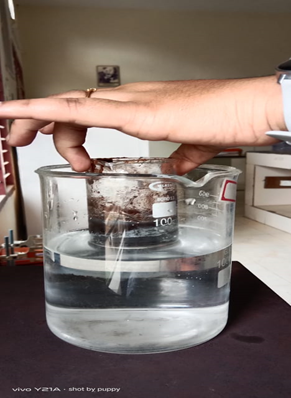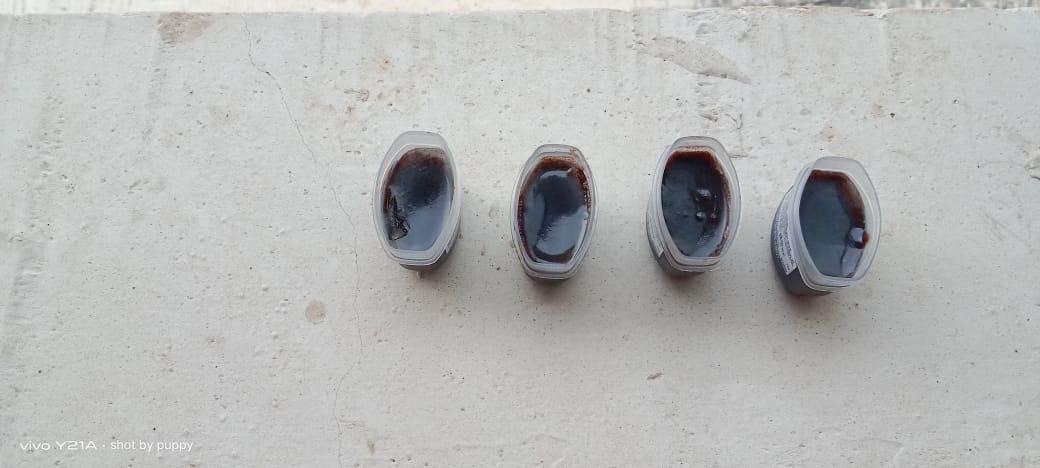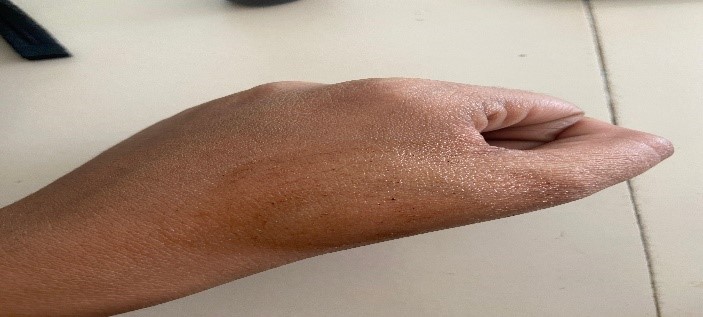Background-Lip balms are widely used to protect and moisturize lips, especially in harsh environmental conditions with increasing consumer preferences for natural products, there is a growing demand for lip balms formulated using natural ingredients. Objective-The aim of the study was to formulate and evaluate a lip balm using natural ingredients, focusing of safety, efficacy, and user acceptability. Materials And Methods-The lip balm was formulated using a blend of natural ingredients such as white petroleum jelly, Almond oil, Rose oils for fragrance and therapeutic benefits. Natural colourants like beetroot extract and antioxidants like Vitamin E were also incorporated. The formulation process involved melting, mixing, and moulding the ingredients into appropriate containers. Results-The lip balm exhibited smooth texture, good spraedability, and an appealing natural appearance. It remained stable without any chemical incomparability and had a pH suitable for application on lips. Conclusion-The formulated lip balm with natural ingredients demonstrated effective moisturizing properties, safety, and user acceptability. It offers a eco-friendly alternative to synthetic lip care products..
Lipbalm with Natural Ingredients, growing demand, melting, mixing, and moulding.
Natural lip balm is a skincare product designed to hydrate, protect, and nourish the lips using plant-based ingredients and natural oils.[1] Unlike traditional lip balms that may contain synthetic chemicals, parabens, and artificial fragrances, natural lip balms rely on organic ingredients such as beeswax, shea butter, coconut oil, cocoa butter, and essential oils. These ingredients work together to lock in moisture, soothe dry or chapped lips, and provide a protective barrier against environmental elements like wind and cold weather.[2] Many natural lip balms also include antioxidants, vitamins, and soothing compounds to promote overall lip health. Natural lip balms are often favoured for their gentle formulation, making them suitable for those with sensitive skin or a preference for eco-friendly, cruelty-free products. Additionally, they are typically free from artificial colours or flavours, offering a more subtle and natural option for lip care.[3]
Trend Toward Natural and Sustainable Cosmetics:
The global cosmetics industry is increasingly adopting more natural and eco-friendly practices, in response to a broader trend toward healthier lifestyles. People are shifting towards natural foods, herbal remedies, and organic products, which extend to personal care products. The use of herbal cosmetics has grown significantly as consumers seek safe, effective, and eco-friendly alternatives to synthetic options that may pose health risks.[4]
Benefits of Natural and Herbal Ingredients:
Natural products, including herbal extracts, have been utilized for centuries for their pharmacological properties such as antimicrobial, anti-inflammatory, and cytostatic effects, making them valuable in personal care products. Herbal cosmetics are particularly valued for their reliability and safety. These products are formulated using plant-based extracts and active ingredients, often regarded as safer than synthetic chemicals, which can have harmful side effects.[5] Difference between lip and regular skin structure
The lips have a unique skin structure that makes them more attractive and distinctive from regular skin. One key difference is the thickness of the top layer of skin. While regular skin has a top layer with 15 to 16 layers, the top layer of lip skin contains only 3 to 4 layers [6]. Another significant difference is the presence of melanin cells. Lip skin contains very few melanin cells, which results in the lovely pinkish color of the lips. This is because the blood vessels underneath the skin are more visible, giving the lips their characteristic hue [7]. In addition to these differences, lip skin also lacks certain features that are present in regular skin. For example, lip skin has no hair follicles, which means that lips are naturally hairless. Furthermore, lip skin also lacks sweat glands, which are responsible for producing sweat and body oil to protect the skin from the outside environment.[8]
Lip Disorders
Swollen lips can be a symptom of allergic reactions to a wide range of substances, such as certain foods, beverages, drugs, cosmetics, or environmental triggers. When the allergen is identified and removed, the swelling usually resolves. However, the cause of the swelling often remains unknown. Hereditary angioedema is a condition that can cause recurrent episodes of lip swelling. Other factors that can lead to swollen lips include non-hereditary conditions like erythema multiforme, sunburn, exposure to cold or dry weather, and injuries.
Prolonged sun exposure can lead to UV-induced damage, which makes the lips, particularly the lower lip, rough and dry. Over time, this damage may manifest as red speckles, white filmy patches, or persistent dryness, significantly increasing the risk of precancerous conditions or lip cancer. To minimize such risks, it is essential to use a lip balm with SPF, seek shade during peak sunlight hours, and wear protective accessories like wide-brimmed hats to block harmful UV light.
Lip inflammation, medically referred to as cheilitis, is a condition characterized by noticeable discomfort and symptoms, including redness, swelling, cracking, and dryness of the lips. This condition can arise due to a variety of causes, such as fungal or bacterial infections, allergic reactions to certain substances, or environmental factors like prolonged sun exposure, wind, or cold weather. In some cases, underlying nutritional deficiencies, such as a lack of vitamin B or iron, may contribute to the problem. If left untreated, lip inflammation can cause persistent irritation and may lead to secondary complications, highlighting the importance of identifying and addressing the root cause.
Pigmentation changes around the lips can appear in various forms, such as freckles or irregular brownish patches known as melanotic macules. These are typically harmless and may remain unchanged for years. However, certain patterns of pigmentation might indicate underlying health conditions. For instance, multiple small, scattered brown-black spots near the lips may be a sign of Peutz-Jeghers syndrome, a genetic disorder associated with gastrointestinal polyps. Additionally, Kawasaki disease, which predominantly affects children under eight years of age, can cause symptoms such as dry lips, cracking, and redness in the oral lining, along with other systemic signs. Persistent or atypical discoloration warrants further medical evaluation to rule out potential underlying causes.[9]
An elevated lesion or a sore with firm edges on the lip might be a warning sign of skin cancer. Similar sores can arise from various medical conditions, including oral herpes simplex and syphilis. Some cases, such as keratoacanthoma, may present with comparable sores without a specific known cause. Furthermore, sores on the lips or inside the mouth may result from trauma caused by accidental biting, poorly fitting dental appliances, or continuous irritation from habits like smoking or chewing tobacco. Autoimmune disorders like lupus or pemphigus are also known to cause painful sores, while deficiencies in nutrients like vitamin B12 or iron can lead to recurring mouth ulcers. It is essential to seek prompt medical attention to identify the underlying cause and ensure the appropriate treatment is administered.[10]
Advantages of natural lip balm
Natural lip balms offer several key benefits that make them an ideal choice for lip care:
- Healing and Moisturizing:
Ingredients like coconut oil and almond oil not only hydrate but also have healing properties, helping to repair damaged lips and maintain long-lasting moisture.
These oils lock in moisture and provide a protective layer, preventing dehydration and keeping lips soft and smooth throughout the day.
- Gentle on Sensitive Skin:
Free from synthetic additives and chemicals, natural lip balms are less likely to cause irritation or allergic reactions, making them suitable for all skin types, including sensitive or allergy-prone lips.
- Versatile and Customizable:
Natural lip balms can be infused with subtle flavors or natural tints, allowing for a personalized touch while maintaining the purity and effectiveness of the ingredients.
- Lip Health and Prevention:
Regular use of natural lip balms helps to reduce the risk of infections, cold sores, and dryness caused by harsh chemicals, promoting healthier lips over time.
Many natural lip balms come in environmentally-friendly packaging, aligning with sustainable practices and contributing to a greener planet.[11]
Types of Lip Balm
There are seven types of lip balms to choose from: tinted lip balm, which doubles as a lipstick; medicated lip balm, often prescribed by dermatologists; flavoured lip balm, which comes with added scents and flavours; organic lip balm, made from natural ingredients; SPF lip balm, offering sun protection for the lips; plumping lip balm, designed to enhance lip fullness; and CBD or hemp oil lip balm, known for its antioxidant and anti-inflammatory properties.
- Tinted Lip Balm:
Tinted lip balm is a type of lip balm designed to both moisturize and add a touch of color to the lips. It serves as an excellent alternative for those who prefer a lighter option over traditional lipstick. Tinted lip balm not only hydrates but also provides a soft, luminous wash of color. It can be applied directly to the lips or with a thin makeup brush for more precise application. This versatile product is essential for its dual benefits of protection and a natural, glowing finish, making it perfect for both daytime looks and nights out.
- Medicated Lip Balm:
Medicated lip balm is a type of lip balm often prescribed by doctors to treat chapped lips and other lip-related conditions. Compared to other lip balms, it is generally less soothing and may cause slight irritation due to its active ingredients. Typically recommended by dermatologists, this lip balm contains healing properties or medicated ingredients, such as hydrocortisone, to address issues like antibacterial infections. To use medicated lip balm, apply it directly to the lips, following the doctor’s instructions. Its specialized formulation makes it essential for providing targeted treatment and relief.
- Flavoured Lip Balm:
Flavoured lip balm is a type of lip balm infused with various flavourings, such as vanilla, mint, mango, and other fruity options. Designed to moisturize the lips, it also appeals to the user's senses with its enticing tastes and scents. Flavoured lip balm is ideal for casual or daily use. To apply, simply glide it directly onto the lips. Its appeal lies in the wide variety of flavours and fragrances available, while still providing effective lip hydration.[12]
- Organic Lip Balm:
Organic lip balm is a type of lip balm made with natural, chemical-free ingredients. Unlike other lip balms that may contain synthetic chemicals potentially harmful to the lips and skin, organic lip balms are typically formulated with ingredients like avocado oil, jojoba oil, beeswax, vitamin E, hemp, and cocoa butter. These balms work like conventional lip balms, providing essential moisture and protection against dryness and chapping. For those seeking a safe and skin-friendly option, organic lip balm is an excellent choice. To use, simply apply directly to the lips to maintain hydration and protection. Its all-natural and chemical-free formulation makes organic lip balm a highly safe and beneficial option for everyday care.
- SPF Lip Balm:
SPF lip balm is a type of lip balm formulated with sun-protective ingredients to shield the lips from the harmful effects of the sun’s rays. Acting like a sunscreen, it helps prevent sunburn, damage, and even serious conditions like skin cancer. For those conscious of skin health and looking to avoid sun exposure's adverse effects, SPF lip balm is an excellent choice for outdoor activities. To use, simply apply directly to the lips for effective sun protection. Its importance lies in minimizing the sun's harmful impact and potentially safeguarding against serious health risks.
- Plumping Lip Balm:
Plumping lip balm is a type of lip balm that not only hydrates but also enhances the lips’ appearance by making them look fuller and more rounded. Formulated to protect the lips, it contains special ingredients that create a visible plumper effect. For those seeking a non-surgical alternative to achieve fuller, more defined lips, plumping lip balm is an ideal choice. It offers an affordable and convenient solution compared to costly lip augmentation procedures. To use, simply apply directly to the lips, allow it to dry, and wait for the tingling sensation to subside. This product is perfect for individuals aiming to achieve a fuller lip look without undergoing invasive treatments.
- CBD or Hemp Oil Lip Balm:
CBD or hemp oil lip balm is a type of lip balm infused with CBD oil or hemp oil. Hemp oil, derived from the hemp plant, serves as an excellent moisturizer, while CBD oil, an active cannabinoid compound, provides anti-inflammatory benefits. This lip balm is particularly effective for addressing issues like cold sores, allergies, irritations, and inflamed lips. Acting as an antioxidant, it soothes dryness and helps heal chapped lips. Simply apply directly to the lips and allow it to dry. CBD or hemp oil lip balm is ideal for those seeking a natural solution to hydrate and repair lips without the risk of allergic reactions.[13]
Ingredients
- Beetroot Powder:
Beetroot extract is a natural compound extracted from beetroot; a root vegetable known for its beetroot color.
- Vitamin E Capsule:
Vitamin E is a naturally occurring vitamin found in various plant-based sources.
- White Petroleum Jelly:
White petroleum jelly, also known as white petrolatum or petroleum jelly, is a semi-solid mixture of mineral waxes and oils derived from petroleum.
- Almond Oil:
Almond oil is typically extracted from sweet almonds (Prunus dulcis) cultivated in Spain, Italy, California, Australia, and the Middle East.
- Rose oil:
Obtained from rose petals through steam distillation, this oil is abundant in antioxidants and essential fatty acids that nourish and repair dry or chapped lips.
Formulation
|
Si. No
|
Ingredients
|
Formulation
|
|
1
|
Beetroot pure extract
|
0.5ml
|
|
2
|
Almond oil
|
2.5ml
|
|
3
|
Vitamin E
|
1ml
|
|
4
|
Rose oil
|
2gm
|
|
5
|
White petroleum jelly
|
2gm
|
Method of Development
- Shift the beetroot powder into a clean beaker.
- Combine white petroleum jelly and almond oil in a beaker and melt them using a water bath.
- Add the remaining ingredients, including vitamin E, beetroot powder, rose oil, and almond oil, to the melted mixture. Mix vigorously and stir continuously until a uniform consistency is achieved.
- Pour the mixture into a container and allow it to air dry at room temperature.
- Before pouring the mixture into lip balm molds, apply glycerine to the molds using cotton. Place the filled molds in an ice bath for 10 minutes to set.
Evaluation
Melting Point:
The lip balm sample was placed in a glass capillary tube with one end sealed using a flame. The capillary containing the sample was immersed in liquid paraffin within a melting point apparatus. The melting process was observed, and the melting point was recorded.


 P. Gayatri Devi* 1
P. Gayatri Devi* 1
 CH. Sravanthi 2
CH. Sravanthi 2
 G. Yagnitha 3
G. Yagnitha 3




 10.5281/zenodo.14808886
10.5281/zenodo.14808886